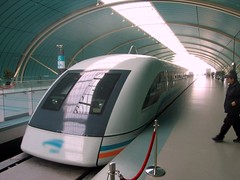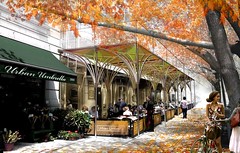Urbanist bloggers who make me think

Posted February 2, 2010 at 1:40PM
Yesterday I indulged in some personal reflection on the state of smart growth, and what, in my opinion, we would be well-served to think about as we consider how our cause might evolve. As with most of us, I suppose, my own thoughts about these things are influenced by experience, observation and discourse among both people I encounter and people whose work I read. I lament that I do much less reading for pleasure than at other times of my life, but I do a huge amount of reading for work.
This involves monitoring a lot of blogs on the subjects of community, development, and sustainability. (Google Reader amalgamates them for me, thank goodness, or this would be a suffocating task.) The blog posts that tend to stick with me are not so much the ones I agree with, but the ones that present issues through a different lens than my own, that are like-minded enough to garner my respect but different enough to challenge and expand my thinking.
Some time ago I mentioned a few blogs and online sources of information that I follow, but I think it’s time to do so again. And this time I am going to highlight just a handful that I find particularly thoughtful and provocative, and that I think readers might not find on their own. These sites not only give me useful information but make me think in new ways:
mammoth: “mammoth is an architectural research, design, and development cartel, currently directed by Stephen Becker and Rob Holmes.  Our interests include extinct megafauna, the production of urban space through the manipulation of infrastructure, landscape processes, and tactical architectural interventions aimed at forestalling the arrival of our inevitably dystopian future and/or ushering in a new era of global harmony.” Weighty stuff, no? The authors are more inclined to essays than updates, the images are just as provocative as the words, and they mimic no one.
Our interests include extinct megafauna, the production of urban space through the manipulation of infrastructure, landscape processes, and tactical architectural interventions aimed at forestalling the arrival of our inevitably dystopian future and/or ushering in a new era of global harmony.” Weighty stuff, no? The authors are more inclined to essays than updates, the images are just as provocative as the words, and they mimic no one.
Word grab: “Elemental, in other words, have exploited the values and aims of ownership culture (which mammoth has suggested understands the house to be first a machine for making money and only second to be a machine for living) not to support a broken system of real estate speculation and easy wealth, but to present architecture as a tool that can be provided to families.”
the Original Green: Steve Mouzon, founder of the New Urban Guild, and I definitely don’t agree on everything – he recently and sharply challenged environmentalists for suggesting that there are places where development should not go, for example – but I have gotten to know and like him. And he practices a consistent philosophy of designing places that are inherently green, not just made green by technology or, as Steve and Wanda Mouzon put it, “the sustainability that existed before the Thermostat Age.” This just makes a ton of sense.  Steve distinguishes “original green” from “gizmo green” in a collection of practice and writing that includes a website and, soon, a book in addition to the blog.
Steve distinguishes “original green” from “gizmo green” in a collection of practice and writing that includes a website and, soon, a book in addition to the blog.
Word grab: “If we hope to stem the tide of consumption, then we need to learn how to design and build things that have many uses again. In other words, double- or triple-duty is just the starting point.”
Rebuilding Place in the Urban Space: Richard Layman is my favorite of the local DC-oriented bloggers and, although his primary perspective is local, you don’t have to be a local reader to learn from his blog. Richard describes himself as “an urban/commercial district revitalization and transportation/mobility advocate and consultant,” and this frequently updated journal dives into topics with detail and analysis from a personal perspective.
Word grab: “In locations that are in relatively less demand, developers stint on the quality of the design on the outside of the building, as well as inside, to bring the building ‘online’ at a price where the developer can make a profit, but at the cost of failing to provide significant ‘increasing returns’ to the place values of urban design, placemaking, and neighborhood revitalization.”
Strong Towns Blog: This is a fairly new site, but so far I am impressed. The three Minnesotan writers of Strong Towns take a decidedly polite and low-key approach to their advocacy, which is largely based around the notion that the places that survive the best will have good urban form because good urban form is much stronger financially and economically than sprawl.  They write in manageably short chunks of words rather than extended essays, but each is well-written and persuasive. Their point of view has very little to do with the environment, at least explicitly, and that helps make it more interesting to me.
They write in manageably short chunks of words rather than extended essays, but each is well-written and persuasive. Their point of view has very little to do with the environment, at least explicitly, and that helps make it more interesting to me.
Word grab: “We are not going to solve any of these problems fighting the American dream. We can, however, start talking the universal language of finance and give all Americans the opportunity to pay the full cost of their dreams themselves. If we did that, we would see our dreams evolve to be more in touch with Levinson's hoped-for reality, albeit with a different motivation (financial, not Utopian).”
Urbanophile: Aaron Renn is probably the best-known blogger on this list. His professional experience is in management and IT consulting, but he claims to be “passionate about cities” and it shows. I wouldn’t call his views contrarian, exactly, but they can be idiosyncratic and he strives to be pragmatic, sometimes to the consternation of other commenters. Based in Indianapolis, Renn’s current topics include transit marketing, the attraction of suburbs, creative class migration, and what economic challenges in Portland might say about its city planning.
Word grab: “If we want to really realize the potential of our urban cores, we need to understand where people are coming from, and figure out how to craft a re-imagining of the good life in an urban context that appeals to a material segment of the public.”
Landscape + Urbanism: Speaking of Portland, that’s where landscape architect Jason King resides. His site says it is about “landscape architecture, sustainable urbanism, vegetated architecture, urban agriculture, living walls, green roofs, ecological planning and landscape urbanism theory.” I don’t go as far as Jason does in advocating all of these things, at least not in as many places, but in part that’s why I like this blog.  He makes the case, makes it much better than most, and illustrates it beautifully with photos and other images. He also wonderfully deviates occasionally from the professional to offer perspective on books, music, food, and the like.
He makes the case, makes it much better than most, and illustrates it beautifully with photos and other images. He also wonderfully deviates occasionally from the professional to offer perspective on books, music, food, and the like.
Word grab: “The re-development of suburbia holds enormous promise both as an adaptation to changing sociology and in the potential for a more sustainable approach to existing forms of development. Multidisciplinary approaches to architecture and urban design will be critical in how this transformation takes shape.”
Sustainable Cities Collective: OK, this is a little self-serving, since I am one of the site’s stable of writers. But there are many others, and they are very, very good. What the editors do in most cases is repost entries from the authors’ home sites when they especially like them. As a result, when the reader goes to Sustainable Cities she sees posts of particular value. The topics are varied, currently from urban reforestation to community economies to electric vehicles to federal transportation policy. If you find a writer you like there, please also follow the link to their home site and read their other work.
Word grab: “Community development, very briefly, is about enabling people in a locality to articulate their needs and concerns and share in developing their own solutions to those needs. It's about moving from being abject recipients of services to deciding what those services should be and eventually running them.”
As I was saying, these are by no means my only blog subscriptions or even all of what I would call “my favorites.” Some require some time to sink into. But they are definitely among the most provocative. Enjoy and learn.